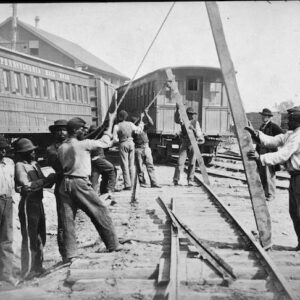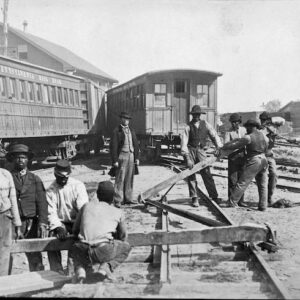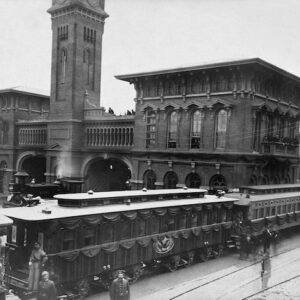Tag: Pennsylvania Railroad (PRR)
Wikipedia says: The Pennsylvania Railroad (reporting mark PRR, legal name The Pennsylvania Railroad Company, also known as the “Pennsy”) was an American Class I railroad that was established in 1846 and was headquartered in Philadelphia, Pennsylvania. It was so named because it was established in the Commonwealth of Pennsylvania.
Beginnings
With the opening of the Erie Canal in 1825 and the beginnings of the Chesapeake and Ohio Canal in 1828, Philadelphia business interests became concerned that the port of Philadelphia would lose traffic. The state legislature was pressed to build a canal across Pennsylvania and thus the Main Line of Public Works was commissioned in 1826. It soon became evident that a single canal would not be practical and a series of railroads, inclined planes, and canals was proposed. The route consisted of the Philadelphia and Columbia Railroad, canals up the Susquehanna and Juniata rivers, an inclined plane railroad called the Allegheny Portage Railroad, a tunnel across the Allegheny Mountains, and canals down the Conemaugh and Allegheny rivers to Pittsburgh, Pennsylvania, on the Ohio River; it was completed in 1834. Because freight and passengers had to change cars several times along the route and canals froze in winter, it soon became apparent that the system was cumbersome and a better way was needed.
There were two applications made to the Pennsylvania legislature in 1846. The first was for a new railroad called The Pennsylvania Railroad Company to build a line between Harrisburg and Pittsburgh, Pennsylvania. The second was the Baltimore and Ohio Railroad (B&O), which wanted to build to Pittsburgh from Cumberland, Maryland. Both applications were granted under conditions. If the Pennsylvania Railroad did not raise enough capital and contract to build enough railroad within a year, then the B&O bill would become effective and the Pennsy’s void, thereby allowing the B&O to build into Pennsylvania and on to Pittsburgh. The Pennsylvania Railroad fulfilled the requirements and Letters Patent were issued by the Pennsylvania governor on February 25, 1847. The governor declared the B&O’s rights void the following August.
Early years
In 1847, the Pennsy’s directors chose J. Edgar Thomson, an engineer from the Georgia Railroad, to survey and construct the line. He chose a route that followed the west bank of the Susquehanna River northward to the confluence with the Juniata River, following its banks until the foothills of the Allegheny Mountains were reached at a point that would become Altoona, Pennsylvania. To traverse the mountains, the line would climb a moderate grade for 10 miles (16 km) until it reached a split of two mountain ravines which were cleverly crossed by building a fill and having the tracks ascend a 220-degree curve known as Horseshoe Curve that limited the grade to less than 2 percent. The crest of the mountain would be penetrated by the 3,612 ft (1,101 m) Gallitzin Tunnels and then descended by a more moderate grade to Johnstown.
The western end of the line was simultaneously built from Pittsburgh, eastward along the Allegheny and Conemaugh rivers to Johnstown, while the eastern end was built from Harrisburg to Altoona. In 1848, the Pennsy contracted with the Harrisburg, Portsmouth, Mountjoy and Lancaster Railroad (HPMtJ&L) to buy and use equipment over both roads, providing service from Harrisburg, east to Lancaster. In 1851, tracks were completed between Pittsburgh and Johnstown. In 1852, a continuous railroad line was now open between Philadelphia and Pittsburgh over the tracks of several entities including the Pennsylvania Railroad. In 1853, the Pennsy was granted trackage rights over the Philadelphia and Columbia, providing a connection between the two cities and connecting with the HPMtJ&L at Lancaster and Columbia. By 1854, the Pennsy completed its line from Harrisburg to Pittsburgh, eliminating the use of the inclined planes of the Allegheny Portage Railroad.
In 1857, the PRR purchased the Main Line of Public Works from the state of Pennsylvania. This purchase included 275 miles (443 km) of canal, the Philadelphia & Columbia Railroad, and the New Portage Railroad (which replaced the now abandoned Allegheny Portage Railroad).[4] The Pennsy abandoned most of the New Portage Railroad in 1857 as it was now redundant with the Pennsylvania Railroad’s own line. In 1861, the Pennsy leased the HPMtJ&L to bring the entire stretch of road between Pittsburgh and Philadelphia under its control.
The Johnstown to Pittsburgh stretch of canal was abandoned in 1865 and the rest of the canals sold to the Pennsylvania Canal Company in 1866.
Showing all 3 results


